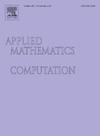A hybrid virtual element method and deep learning approach for solving one-dimensional Euler-Bernoulli beams
IF 3.5
2区 数学
Q1 MATHEMATICS, APPLIED
引用次数: 0
Abstract
A hybrid framework integrating the Virtual Element Method (VEM) with deep learning is presented as an initial step toward developing efficient and flexible numerical models for one-dimensional Euler-Bernoulli beams. The primary aim is to explore a data-driven surrogate model capable of predicting displacement fields across varying material and geometric parameters while maintaining computational efficiency. Building upon VEM's ability to handle higher-order polynomials and non-conforming discretizations, the method offers a robust numerical foundation for structural mechanics. A neural network architecture is introduced to separately process nodal and material-specific data, effectively capturing complex interactions with minimal reliance on large datasets. To address challenges in training, the model incorporates Sobolev training and GradNorm techniques, ensuring balanced loss contributions and enhanced generalization. While this framework is in its early stages, it demonstrates the potential for further refinement and development into a scalable alternative to traditional methods. The proposed approach lays the groundwork for advancing numerical and data-driven techniques in beam modeling, offering a foundation for future research in structural mechanics.
求解一维欧拉-伯努利梁的混合虚元法和深度学习方法
将虚拟元法(VEM)与深度学习相结合,提出了一种混合框架,作为开发一维欧拉-伯努利梁高效灵活数值模型的第一步。主要目的是探索一种数据驱动的替代模型,能够在保持计算效率的同时预测不同材料和几何参数的位移场。基于VEM处理高阶多项式和非一致性离散化的能力,该方法为结构力学提供了坚实的数值基础。引入神经网络架构分别处理节点和特定材料的数据,有效地捕获复杂的交互,最大限度地减少对大型数据集的依赖。为了解决训练中的挑战,该模型结合了Sobolev训练和GradNorm技术,确保平衡损失贡献和增强泛化。虽然这个框架还处于早期阶段,但它展示了进一步改进和开发成为传统方法的可扩展替代方案的潜力。提出的方法为推进梁模型的数值和数据驱动技术奠定了基础,为未来的结构力学研究奠定了基础。
本文章由计算机程序翻译,如有差异,请以英文原文为准。
求助全文
约1分钟内获得全文
求助全文
来源期刊
CiteScore
7.90
自引率
10.00%
发文量
755
审稿时长
36 days
期刊介绍:
Applied Mathematics and Computation addresses work at the interface between applied mathematics, numerical computation, and applications of systems – oriented ideas to the physical, biological, social, and behavioral sciences, and emphasizes papers of a computational nature focusing on new algorithms, their analysis and numerical results.
In addition to presenting research papers, Applied Mathematics and Computation publishes review articles and single–topics issues.

 求助内容:
求助内容: 应助结果提醒方式:
应助结果提醒方式:


